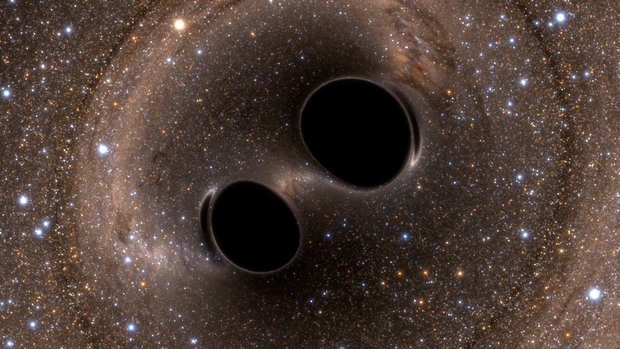
What does the collision of two black holes “sound” like? Scientists from the Laser Interferometer Gravitational-Wave Observatory (LIGO) Scientific Collaboration have just announced that they have discovered evidence of gravitational waves, proving a major prediction of Albert Einstein’s 1915 general theory of relativity right.
A rising tone recorded from the collision of two black holes, 29 and 36 times the mass of the sun, over a billion light-years away, with an energy 50 times greater than the peak output of all the stars in the universe put together, or the mass of three Suns converted into energy at a fraction of a second, provides the first direct evidence of gravitational waves.
The theory of general relativity states that black holes lose energy as they orbit each other via the emission of gravitational waves. Over the course of billions of years, they slowly approach each other before finally locking into a lover’s embrace, moving at half the speed of light in the final minutes before merging into an even bigger black hole. A portion of the black hole’s mass is instantly converted to energy – a final enormous blast of gravitational waves. Or, as detected by LIGO, a soft chirp.
“This detection is the beginning of a new era: The field of gravitational wave astronomy is now a reality,” said Gabriela González, spokeswoman for the Louisiana State University.
“I think this will be one of the major breakthroughs in physics for a long time,” said one of the LIGO scientists, Szabolcs Marka. “Everything else in astronomy is like the eye. Finally, astronomy grew ears. We never had ears before.”
“Until now, we scientists have only seen warped space-time when it’s calm,” said Dr. Thorne, from the the California Institute of Technology, in an email. “It’s as though we had only seen the ocean’s surface on a calm day but had never seen it roiled in a storm, with crashing waves.”
The collision of the two super-massive singularities created an enormous storm “in which the flow of time speeded, then slowed, then speeded. A storm with space bending this way, then that.”
“With this discovery, we humans are embarking on a marvelous new quest: the quest to explore the warped side of the universe—objects and phenomena that are made from warped spacetime. Colliding black holes and gravitational waves are our first beautiful examples,” says Thorne.
The construction of the two LIGO detectors, located in Livingston, Louisiana, and Hanford, Washington, USA, cost the National Science Foundation a whopping 1.1 billion dollars and took 40 years to build; but it was worth it to detect the single chirp.
Each LIGO detector consists of L-shaped antennas and dual 2.5 mile-long arms running perpendicularly to each other.

“Our observation of gravitational waves accomplishes an ambitious goal set out over 5 decades ago to directly detect this elusive phenomenon and better understand the universe, and, fittingly, fulfills Einstein’s legacy on the 100th anniversary of his general theory of relativity,” says executive director of the LIGO Laboratory, David H. Reitze.
This Article (Einstein’s Predicted Gravitational Waves Detected on 100th Anniversary of General Theory of Relativity) is a free and open source. You have permission to republish this article under a Creative Commons license with attribution to the author(CoNN) and AnonHQ.com.




